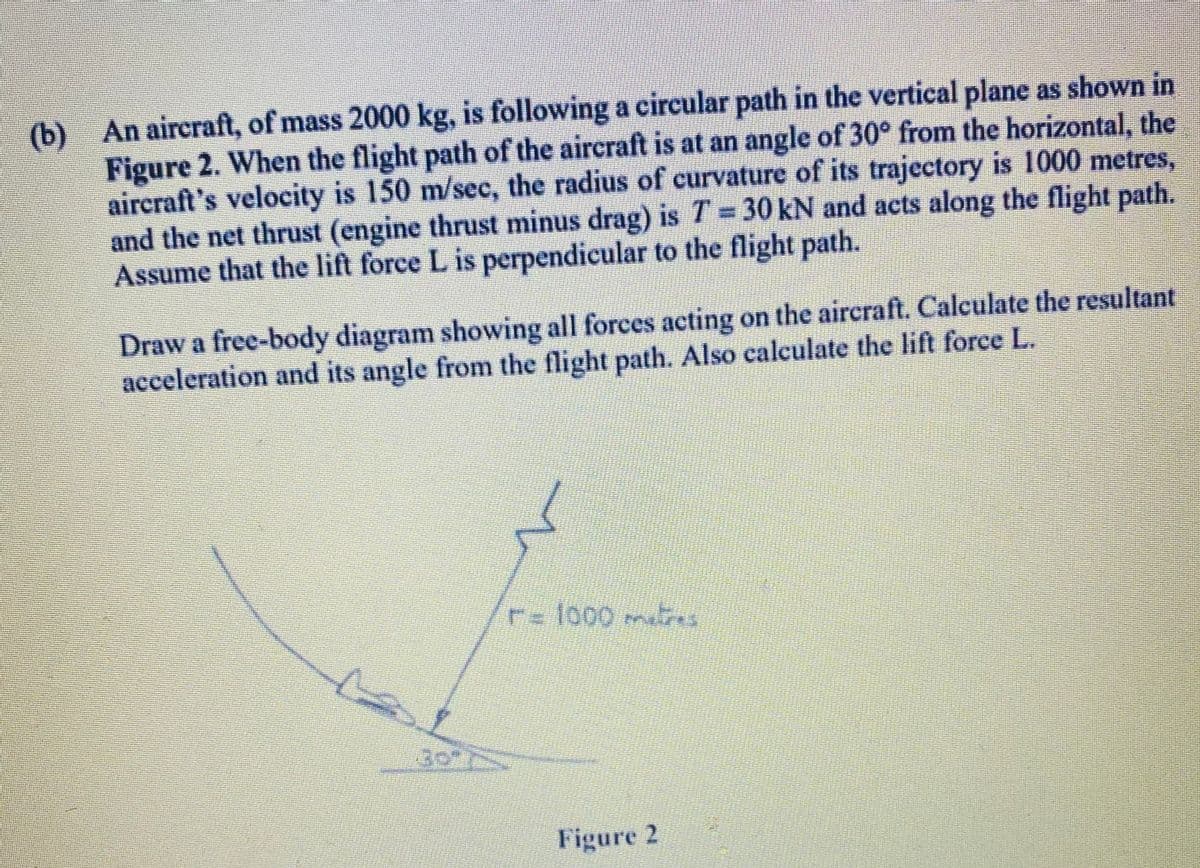b) An aircraft, of mass 2000 kg, is following a circular path in the vertical plane as shown in Figure 2. When the flight path of the aircraft is at an angle of 30° from the horizontal, the aircraft's velocity is 150 m/sec, the radius of curvature of its trajectory is 1000 metres, and the net thrust (engine thrust minus drag) is T= 30 kN and acts along the flight path. Assume that the lift force L is perpendicular to the flight path. Draw a free-body diagram showing all forces acting on the aircraft. Calculate the resultant acceleration and its angle from the flight path. Also calculate the lift force L. T= 1000 mtes 307
b) An aircraft, of mass 2000 kg, is following a circular path in the vertical plane as shown in Figure 2. When the flight path of the aircraft is at an angle of 30° from the horizontal, the aircraft's velocity is 150 m/sec, the radius of curvature of its trajectory is 1000 metres, and the net thrust (engine thrust minus drag) is T= 30 kN and acts along the flight path. Assume that the lift force L is perpendicular to the flight path. Draw a free-body diagram showing all forces acting on the aircraft. Calculate the resultant acceleration and its angle from the flight path. Also calculate the lift force L. T= 1000 mtes 307
Classical Dynamics of Particles and Systems
5th Edition
ISBN:9780534408961
Author:Stephen T. Thornton, Jerry B. Marion
Publisher:Stephen T. Thornton, Jerry B. Marion
Chapter9: Dynamics Of A System Of Particles
Section: Chapter Questions
Problem 9.62P
Related questions
Question

Transcribed Image Text:(b) An aircraft, of mass 2000 kg, is following a circular path in the vertical plane as shown in
Figure 2. When the flight path of the aircraft is at an angle of 30° from the horizontal, the
aircraft's velocity is 150 m/sec, the radius of curvature of its trajectory is 1000 metres,
and the net thrust (engine thrust minus drag) is T = 30 kN and acts along the flight path.
Assume that the lift force L is perpendicular to the flight path.
%3D
Draw a free-body diagram showing all forces acting on the aircraft. Calculate the resultant
acceleration and its angle from the flight path. Also calculate the lift force L.
P= 1000 ms
Figure 2
Expert Solution
This question has been solved!
Explore an expertly crafted, step-by-step solution for a thorough understanding of key concepts.
This is a popular solution!
Trending now
This is a popular solution!
Step by step
Solved in 3 steps with 3 images

Knowledge Booster
Learn more about
Need a deep-dive on the concept behind this application? Look no further. Learn more about this topic, physics and related others by exploring similar questions and additional content below.Recommended textbooks for you

Classical Dynamics of Particles and Systems
Physics
ISBN:
9780534408961
Author:
Stephen T. Thornton, Jerry B. Marion
Publisher:
Cengage Learning

Classical Dynamics of Particles and Systems
Physics
ISBN:
9780534408961
Author:
Stephen T. Thornton, Jerry B. Marion
Publisher:
Cengage Learning